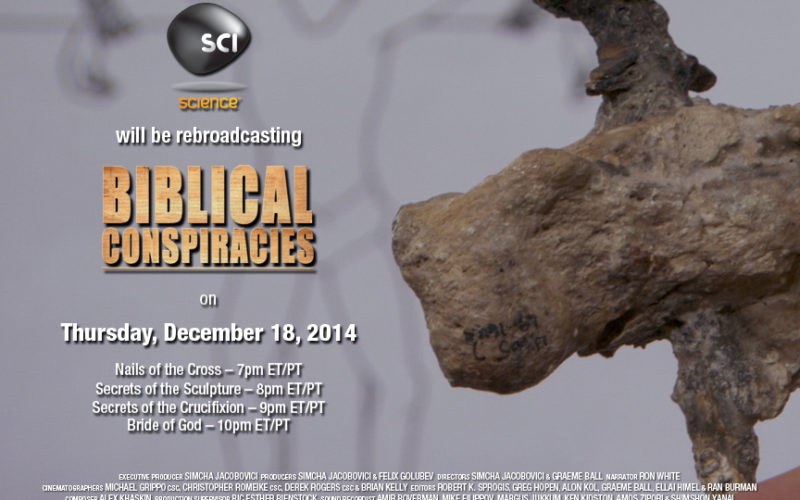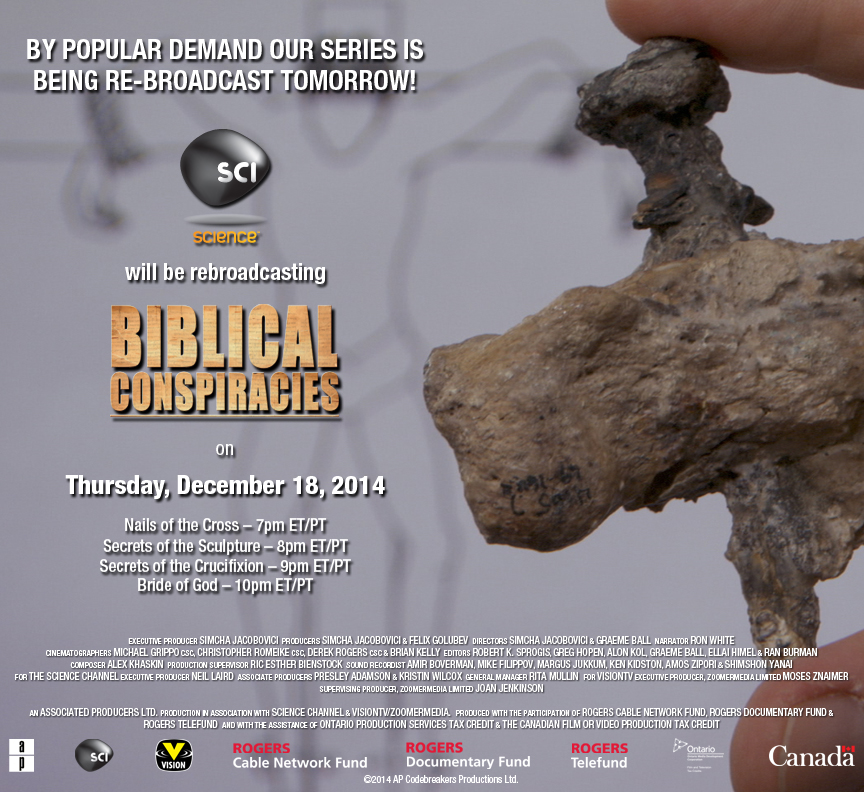Wood From the “True Cross” Found?
Here’s a scoop you won’t read anywhere else: According to a new study and a documentary (“Biblical Conspiracies: Nails of the Cross”) that is getting broadcast exclusively on the Science Channel in the US (Thursday, December 18th at 7/6c and Tuesday, December 23rd at 10/9c), the nails of Jesus’ crucifixion have been identified – and there’s still bone/phosphorous residue and slivers of ironized wood adhering to the nails!
How do I know this? I’m the film’s director. I have been following this story for five years. In April of 2011, I held a press conference during which I argued the following:
- It is a fact recognized by most scholars that the tomb of the High Priest Caiaphas has been found. Caiaphas is the High Priest who, according to the Gospels, sent Jesus to the Romans who then sent him to the cross. His tomb was discovered in 1990 in a suburb of Jerusalem. His extremely ornate ossuary (bone box) i.e., limestone coffin, is on permanent display in the Israel Museum.
- Among the various objects found in the tomb e.g., ossuaries, an oil lamp and a jug, archeologists discovered two 8 centimeters long Roman nails. Despite the fact that Caiaphas is known in history for one thing – and one thing only – the crucifixion of Jesus, the Israeli archaeologists who excavated the tomb did not photograph the nails, draw them, or catalog them. In fact, the Israel Antiquity Authorities (IAA) lost them or, more correctly, misplaced them. And that was that. No headlines and no fanfare.
- In 2010, I located two nails in the forensic anthropology lab of Tel Aviv University that I believed were the missing nails from the Caiaphas tomb. The Tel Aviv lab is under the direction of Professor Israel Hershkovitz. He had received the nails a decade earlier from the IAA in Jerusalem. Based on their size, shape and the fact that their ends were bent, Professor Hershkovitz surmised that they were crucifixion nails, most probably used to secure the hands of a crucified man.
- Based on the above, I concluded that the crucifixion nails in Professor Hershkovitz’s lab are the missing nails from the Caiaphas tomb, and that they must have been the very nails driven through Jesus’ hands.
My claims made international headlines but were met with near universal criticism and even ridicule. How do we really know that the nails in Professor Hershkovitz’s lab are the missing Caiaphas nails, my critics said. Besides, even if they did originate in the Caiaphas tomb, how do we know that they were involved in a crucifixion? Finally, if they were involved in a crucifixion, how do we know that they were used in the crucifixion in the Jesus of Nazareth? Even some of my closest friends and allies said that this time – and I am no stranger to controversy – I had gone too far.
One of my staunchest critics was Geo-Archaeologist Dr. Aryeh Shimron. He said that the whole theory was far fetched but that, in theory, it could be scientifically tested. I asked him if he would do the science. His answer was: “You probably won’t like what I find.” In response, I said that I was just interested in the truth. The only thing I did ask him for was the exclusive right to document his scientific work. He agreed. The work took several years. The results are in. I can now report that a leading scientific magazine is presently analyzing the study.
What I can also say is that the findings are nothing less than astounding. Dr. Shimron discovered that the Caiaphas tomb has a unique chemical signature, derived from flooding, perhaps from a nearby aqueduct. He also found that the nails in Professor Hershkovitz’s lab perfectly match the Caiaphas tomb’s chemical signature. In fact, he was able to trace the nails to the bone box of the High Priest himself. But more than this, he even found traces of phosphorous on the nails, indicating contact with bones. Most dramatically, while examining the nails under an electron microscope with Dr. Vitaly Gutkin, he found pieces of ironized wood still adhering to the nail! Switzerland’s Dr. Werner Schoch, the world’s foremost expert on ancient wood, was able to identify the species of wood as…cedar.
So it’s now a fact – not conjecture – that Caiaphas, the man who is identified with Jesus’ crucifixion, took two crucifixion nails with him to the grave.
Are these the very nails that were driven through Jesus’ hands? And if so, why did Caiaphas want to be buried with them?
My new book (with Professor Barrie Wilson) “The Lost Gospel: Decoding the Ancient Text that Reveals Jesus’ Marriage to Mary the Magdalene” is now available.


